Adaptation Communication
October
The Government of Taiwan

Contents I. Background .......................................................................... II. National Conditions ............................................................. III. Impact, Adaption and Vulnerability ..................................... IV. Institutional and Legal Framework to Implement Climate Change Adaptation ............................................................. V. Climate Adaptation Measures and Achievements .............. VI. International cooperation ..................................................
Table of
List of Figures
Fig. Annual average temperature trend in Taiwan ............. ........
Fig. Long-term change trend of the length of winter and summer in Taiwan .............................................. ..................
Fig. Annual maximum -day precipitation amount change trend in Taiwan ................................................................................................ 4
Fig. Annual maximum consecutive dry days trend in Taiwan change trend in Taiwan ..................................................................... 5
Fig. Estimation of future spatial distribution and number of days .......................................................................................................... 5
Fig. Estimation of future length of seasons in Taiwan .................... 6
Fig. Spatial distribution and intensity estimation of future annual maximum -day rainstorm in Taiwan ............................. 7
Fig. Estimation of future changing trend of typhoon characteristics in Taiwan ................................................................... 7
Fig. Estimation of the future trend ........................................................ 8
Fig. Estimation of the maximum number of consecutive days without rainfall and the future trend of spring flow in the water resources division ................................................................. 10
Fig. Estimation of future sea-level rise change trend in Tai nan area ........................................................................................................ 11
Fig. Institutional work distribution among ministries ................ 13
Fig. main regulations for driving climate change adaptation .. 14
Fig. Summary of Climate Change Adaptation Chapter of Climate Change Response Act (draft) ................................. 15
I. Background
The th United Nations Climate Change Conference (COP ) Resolution /CMA. invites parties that have not yet submitted an Adaptation Communication (ADCOM) to do so by COP (November - , ), in order to provide timely information for the Global Stocktake and facilitate the setting of Global Goal on Adaptation (GGA). Although Taiwan is not a party, in response to the call of UNFCCC resolution, , we have prepared the Adaptation Communication before the due date as follows, for the reference of our domestic and international counterparts.
II. National Conditions
The Republic of China (Taiwan) has jurisdiction over the main island of Taiwan and its affiliated islands, the Penghu Islands, the Kinmen Islands, the Matsu Islands, the Dongsha Islands, and the Nansha Islands, with a total area of , square kilometers. The main island of Taiwan is located on the southeastern edge of the Asian continental shelf, between the st and th north parallels, with the Tropic of Cancer ( . degrees North Latitude) passing through Chiayi County. Taiwan has a north-south length of kilometers and a maximum width of kilometers from east to west. Surrounded by the Pacific Ocean to the east, the Taiwan Strait to the west, and the Bashi Channel to the south, Taiwan has a total coastline of , kilometers. The topography is high in the east and low in the west, with
1
Adaptation Communication
mountains, hills, basins, terraces, and plains as the main features.
Taiwan has a subtropical and tropical oceanic climate and is located in the Asian monsoon region. In winter, it is affected by the northeast monsoon due to the continental cold high, and in summer, it is affected by the southwest monsoon due to the monsoon low. Taiwan's temperature shows a continuous upward trend, of a magnitude that is more obvious than the overall rise of global temperature. The year was the warmest in Taiwan's meteorological records, with an annual average temperature of . °C, about °C higher than the climatic average. The main sources of rainfall include spring rains, East Asian monsoon rains, typhoons, southwesterly flow rains and northeast monsoon. The average total annual rainfall in was , . mm, which is . mm lower than the climatic average and only % of the climatic average of , . mm. The year was the seventh least rainy year in the country's meteorological records. Especially in the central mountain area, rainfall was only about - % of the climatic average.
III. Impact, Adaption and Vulnerability
In response to the latest scientific data of the Sixth Assessment Report (AR ) released by the Intergovernmental Panel on Climate Change (IPCC), the National Science and Technology Council (NSTC) and other government agencies jointly released a report presenting the historical climate change
Communication 2
Adaptation
data and the latest future projections for Taiwan, and presented the results of research carried out by scientific teams on the impact of climate change to help the public understand how climate change will affect the country.
According to local observation and analysis, the annual average temperature in Taiwan increased by about . °C from to , and this temperature increase has accelerated in the past years and the past years (Figure ).
Fig. Annual average temperature trend in Taiwan

Image source :NSCT

Adaptation Communication 3
In terms of the distribution of seasons, the length of summer has increased to about - days in the early st century, while the length of winter has shortened to about days and to about - days in recent years (Figure ).
Fig. Long-term change trend of the length of winter and summer in
Image source: NSCT
Fig 2
In terms of rainfall, the trend of total annual precipitation did not change significantly, but the annual max -day precipitation amount shows an significant increasing trend from and (Figure ), and the trend of annual maximum consecutive dry days changed significantly, with an increase of about . days per century (Figure ).
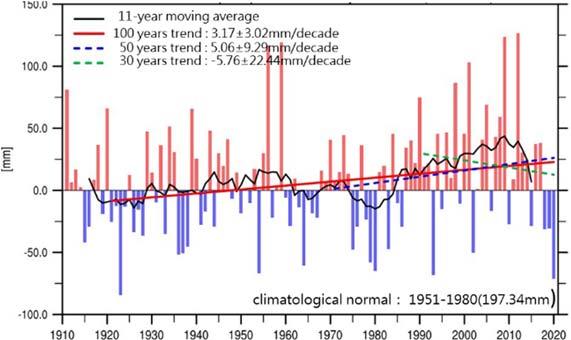
Fig. Annual maximum -day precipitation amount change trend in Taiwan
Image source: NSCT
Communication 4
Adaptation
Fig. Annual maximum consecutive dry days trend in Taiwan change trend in Taiwan


Image source: NSCT

It is estimated that the worst global warming scenario with high greenhouse gas emissions (SSP - . ) will have a significantly greater impact on the country than the ideal mitigation scenario (SSP - . ). In terms of temperature, under the worst-case scenario, the number of days with daily maximum temperatures above °C will increase by about days by the end of this century; under the ideal mitigation scenario, the number of days will only increase by . days (Figure ).
Image source: NSCT
Fig. Estimation of future spatial distribution and number of days

Adaptation Communication 5
Considering the seasonal length change, the length of summer will increase from about days to - days, while the length of winter will decrease from about days to - days. The changing trend was significant in the worst-case scenario and relatively moderate in the ideal mitigation scenario (Figure ).

Fig. Estimation of future length of seasons in Taiwan Image source: NSCT
The annual maximum -day precipitation amount associated with disaster impact will increase by about . % at the end of the st century under the worst-case scenario, and by about . % under the ideal mitigation scenario (Figure ).

Adaptation Communication 6
Image source: NSCT
Fig. Spatial distribution and intensity estimation of future annual maximum -day rainstorm in Taiwan

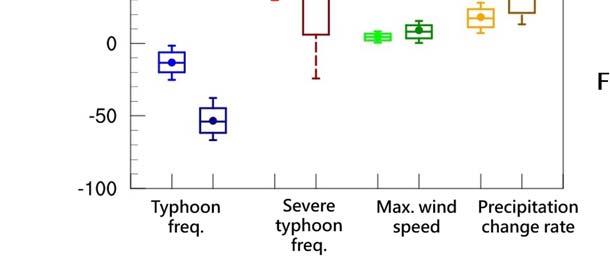

Under the worst-case scenario (RCP . ), the number of typhoons affecting Taiwan will decrease by % and % by the middle and end of the century respectively, but the severe typhoons will increase by % and %, while the typhoon rainfall change rate will increase by % and % respectively (Figure ).
Fig. Estimation of future changing trend of typhoon characteristics in Taiwan
Image source: NSCT
Communication 7
Adaptation
The various impact factors derived from climate change will affect sectors in Taiwan differently. Amongst all the factors the ones with potential significant impact on the country can be summarized as follows: temperature (hot and cold), rainfall (wet and dry), coast and ocean (sea level rise, marine heatwaves, ocean acidification, etc.). The following summarizes the potential impact on various sectors based on changes in temperature, rainfall, and sea level rise.

Under the future warming scenario, in agriculture, rice production in Taiwan shows a decreasing trend, and the average yield reduction of the second crop is more obvious than that of the first crop (Figure ).
Fig. Estimation of the future trend Image source: NSCT

Communication 8
Adaptation
In terms of public health, the distribution of Aedes aegypti may extend northward across the existing border of Tainan-Chiayi in the middle of the century and there is also a trend of extending northward in the eastern part of Taiwan, leading to an increased risk of Dengue Hemorrhagic Fever at the end of the century.
Under the future warming scenario, there will be an increase in extreme rainfall intensity, a decrease in the chance of typhoons hitting Taiwan and a change in rainfall patterns. In terms of flooding impact, all regions showed an increasing trend except for the central region, which showed a slight decrease in the middle of the century. In terms of the impact of slope failure disaster, all regions showed an increasing trend in the middle of the century, except for the central mountainous areas. This increasing trend becomes more obvious at the end of the century. In terms of water resources, the fluctuation of river flow between wet and dry seasons in catchment areas became larger, and the flow in spring generally showed a decreasing trend in the middle of the century. This change was more significant at the end of the century, which may increase the risk of drought (Figure ).
Adaptation Communication 9
s
Fig. Estimation of the maximum number of consecutive days without rainfall and the future trend of spring flow in the water resources division Image source: NSCT
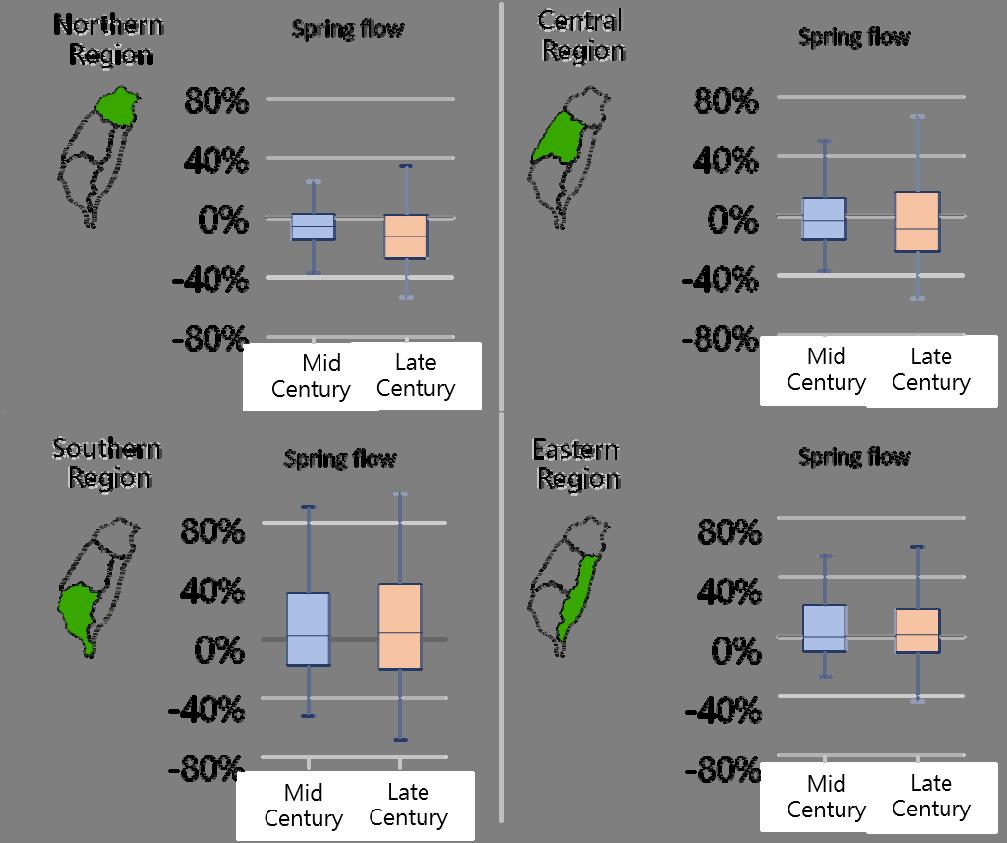
Communication 10
Adaptation
Under the worst future warming scenario (RCP . ), the wind speed of typhoons will increase by about % to % at the end of the century, with an average increase of %. Due to its innate geography, the impact of typhoons and waves along the coast of Taiwan is greater on the northeast and southeast coasts, while the impact of storm surges is greater on the north, northeast and central coasts, therefore the impact on these areas will be higher than other areas under the warming scenario. According to the IPCC AR , in a °C warming scenario, the sea level around Taiwan will rise by about . meters, and in a °C warming scenario, the sea level will rise by . meters. Taking the Taipei metropolitan area as an example, sea level rise may lead to flooding in areas mainly located in the estuary of the Danshui River. Under the protection of existing dikes, the impact on urban areas will be relatively small. In southwestern coastal areas such as the Tainan area, sea level rise may cause an overflow in lowlands, especially in coastal fish farms, wetlands, and sandbars (Figure ).
Fig. Estimation of future sea-level rise change trend in Tainan area

Image source: NSCT

Communication 11
Adaptation
IV. Institutional and Legal Framework to Implement Climate Change Adaptation
The development of Taiwan s climate change adaptation policy was initiated by the Council for Economic Planning and Development of the Executive Yuan (now the National Development Council). In , the Academia Sinica was commissioned to establish a crossdisciplinary team, and invited relevant ministries, experts and scholars, NGOs and industry representatives to set up the task force for Planning and Promoting Climate Change Adaptation Policy Guidelines and Action Plans. Review meetings, regional symposiums and national climate change conferences were held successively to solicit opinions from all sectors and to build consensus. On June , , the Executive Yuan approved the framework for Adaptation Strategy to Climate Change in Taiwan. Taking into consideration the practices of countries around the world, as well as the unique characteristics of the country's environment and historical experience, eight sub-groups in the adaptation field were established under the aforementioned task force to formulate relevant strategies, implement promotion mechanisms and supporting measures. In May , the National Climate Change Adaptation Plan ( - NAP) was finalized in conjunction with various ministries.
Adaptation Communication 12
Afterwards, the Environmental Protection Administration (EPA) completed the legislation of the Greenhouse Gas Reduction and Management Act in and formulated the National Climate Change Action Guideline in . In , the EPA convened ministries including the National Development Council to jointly draft the National Climate Change Adaptation Action Plan ( - NAP), which serves as the institutional framework to implement the climate change adaptation works. The distribution of work among ministries is shown in Figure .
Fig. Institutional work distribution among ministries
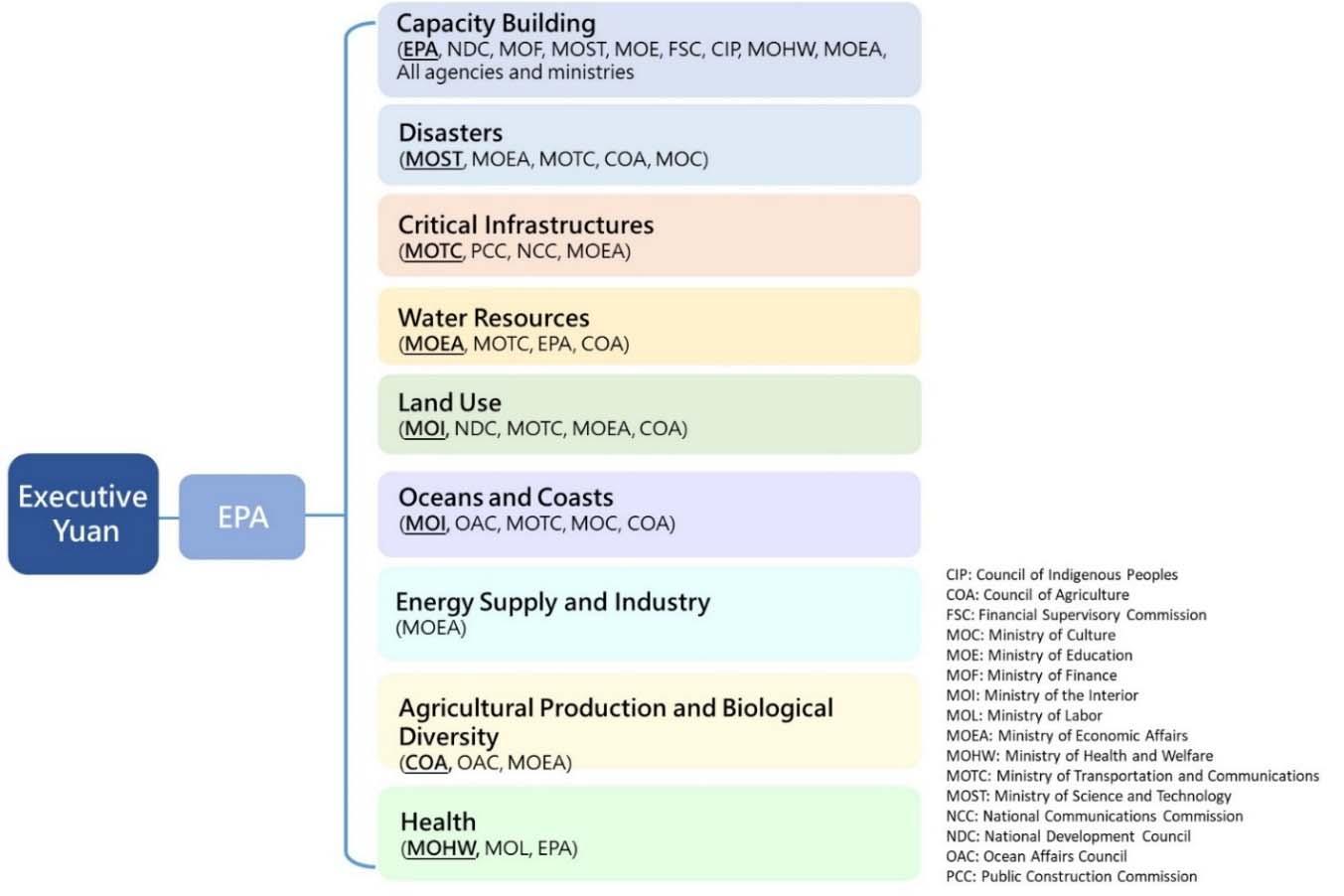
13
Adaptation Communication
The legal framework to justify the implementation of climate change adaptation is mainly composed of the Greenhouse Gas Reduction and Management Act, Spatial Planning Act, Coastal Zone Management Act, Water Act, Wetland Conservation Act Agriculture InsuranceActandNationalParkLaw,which are highlighted in Figure .
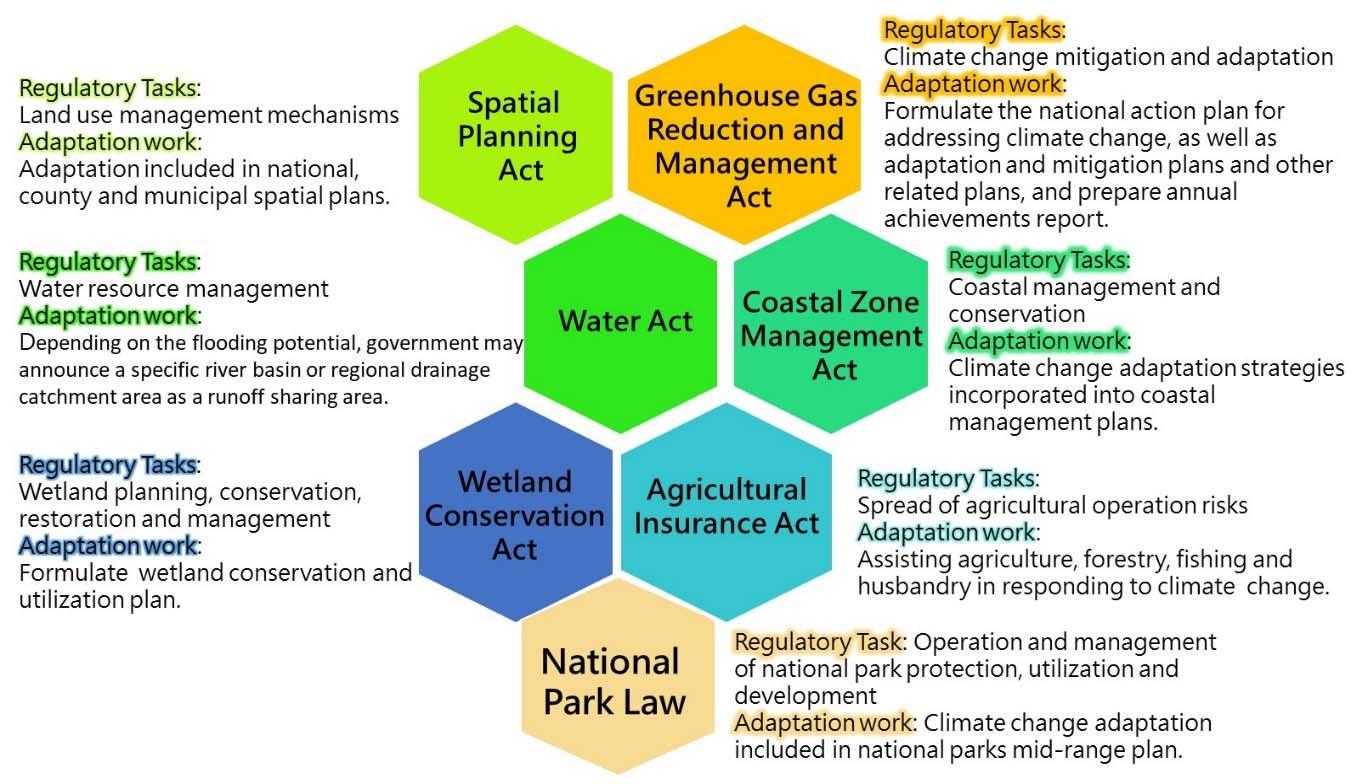
Fig. main regulations for driving climate change adaptation
.Greenhouse Gas Reduction and Management Act
In , theGreenhouseGasReductionandManagementAct of Taiwan entered into force, which incorporates the mitigation goal in the Act and makes the legislation a comparatively ambitious one in the world. Envisioning the more and more serious climate emergency the EPA proposed a draft Bill to amend to the Greenhouse Gas
Communication 14
Adaptation
Reduction and Management Act in October , titled as Climate ChangeResponseActso as to cope with the new climate change threats. The Bill has been submitted to the Legislative Yuan for deliberation on April , . The main features on the new Bill include incorporating the net zero emission target into law, upgrading the level of climate governance, adding a special chapter on climate change adaptation, strengthening emission controls and incentive mechanism to promote carbon emission reduction, as well as and charging carbon fees for dedicated use. The main coverage of the climate change adaptation are illustrated in Figure .
Fig. Summary of Climate Change Adaptation Chapter of Climate Change Response Act (draft)
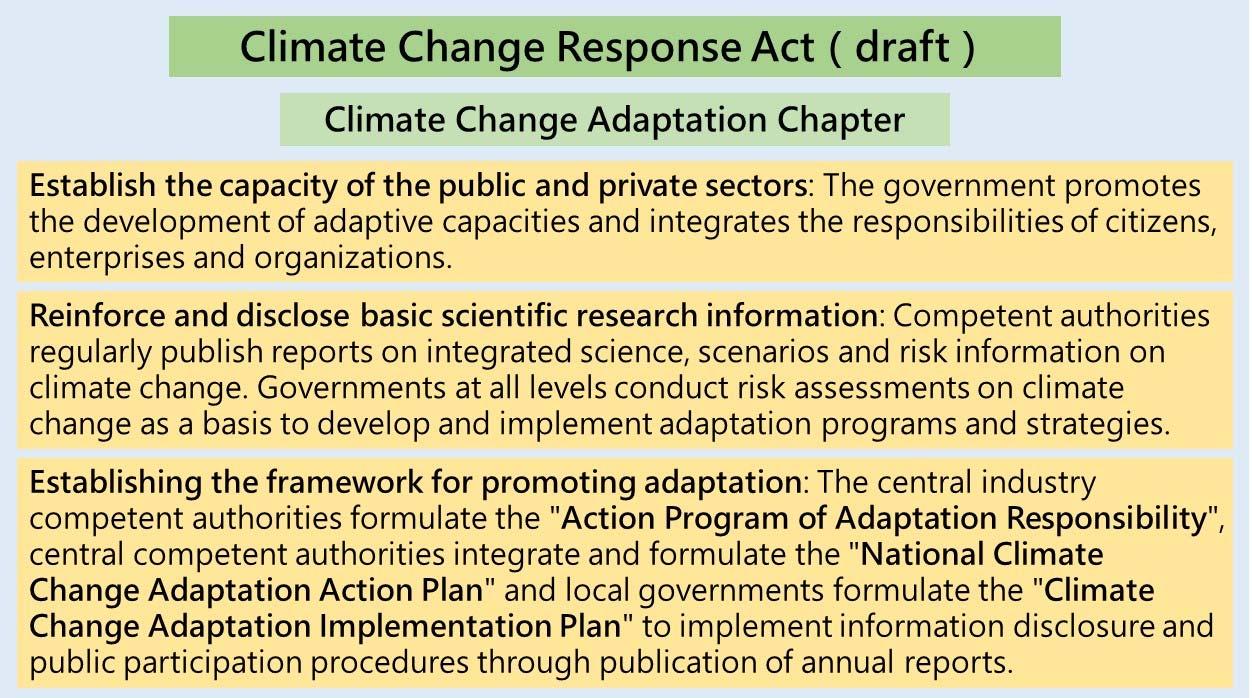
Adaptation Communication 15
. Spatial Planning Act
The substantive contents of the Spatial Planning Act include establishing a national spatial plan, confirming the priorities of the spatial plan, delineating the functional zones of the land, establishing a licensing system, establishing an information disclosure mechanism, including citizen participation in supervision, promoting environmental restoration and sustainable development, protecting civil rights, as well as developing a compensation and relief mechanism. The Spatial Planning Act came into force on May , , stating that the contents shall include climate change adaptation strategies and "the content of the national spatial plan for special municipality and counties shall include climate change adaptation plans.
. Coastal Zone Management Act
Taiwan is surrounded by sea with a total coastline of , kilometers and a large area of coastal land. To implement integrated coastal management and promote the sustainable development of coastal areas, the government promulgated the Coastal Zone Management Act in February , stating that disaster prone coastal zones shall adopt indented buildings or adjust its land use in response to climate change and the risk of coastal disaster. It also states that "the Central Competent Authority shall formulate a integrated coastal
Adaptation Communication 16
zone management plan for the conservation, protection, utilization, and management of land in coastal zones."
. Water Act
The WaterActis the legal basis for water resources administration and construction of waterworks in Taiwan. It s aimed to ensure the supply and demand of water resources. Climate change, a higher frequency of extreme rainfalls, as well as high urbanization and largescale land development in the middle and upper reaches of rivers all contribute to the increased risk of flooding. Therefore, a new chapter on Runoff Allocation and Outflow Control was added to the law in May
, requiring land and building developers to jointly share the responsibilities for flood retention and water storage so as to improve the overall flood resistance of the land.
. Wetland Conservation Act
To ensure natural flood retention and other functions of wetlands, maintain biodiversity, as well as promote ecological conservation and wise use of wetlands, the eWetland Conservation Act was enacted in February . Wise use being the core spirit of the law, with conservation and use plans formulated for each wetland according to its different characteristics, while respecting the existing use by citizens,
Communication 17
Adaptation
in order to find a balance between citizen s rights, local development and environmental protection. Among them, "wise use" refers to the use of wetland resources in an inclusive manner within the ecological carrying range of wetlands, maintaining quality and quantity in a stable state, and providing timely, appropriate, and permanent management of biological resources, water resources and land.
. Agricultural Insurance Act
According to statistics, the average annual agricultural loss from natural disasters in Taiwan over the past years is approximately NT$ . billion. Given the increasing severity of global warming and climate change, it is necessary to help the sectors of agriculture, forestry, fishery, and husbandry spread agricultural business risks by enacting a special law. TheAgriculturalInsuranceActcame into force in Taiwan on January , . The important measures include subsidizing farmers' insurance premiums, establishing a risk spreading mechanism, providing insurers with preferential taxation and assisting in damage inspection, etc., to ensure farmers' income security.
. National Park Law
National parks are established for the purpose of protecting the nation's unique natural scenery, wildlife and historical sites, as well as
Adaptation Communication 18
setting aside areas for public recreation and scientific research. The vast natural vegetation areas of national parks are important sites for carbon sequestration that can help mitigate climate change. In response to global environmental changes, national parks can help promote ecological restoration, environmental education and eco tourism experience, reduce the impact of recreational behavior on the environment, enhance people's reflection on global warming and contribute to the implementation of the concept of sustainable development.
Adaptation Communication 19
V. Climate Adaptation Measures and Achievements
The new term of the National Climate Change Adaptation Action Plan ( - NAP), which serves as a consecutive institutional framework proposed by the original National Climate Change Adaptation Plan ( - NAP), aims to "develop strategies to respond to climate change, improve adaptation capacity, strengthen resilience, and reduce vulnerability to the impact of climate change to ensure sustainable national development." NAP defines eight areas of adaptation and capacity building: disasters, critical infrastructures, water resources, land use, oceans and coasts, energy supply and industry, agricultural production and biological diversity, as well as health. NAP outlines a total of action plans, among which are designated as priority action plans, that promote Taiwan s adaptation work to reduce vulnerability and strengthen resilience, and align the Taiwan Sustainable Development Goals with the United Nations Sustainable Development Goals. The government will regularly disclose the climate change adaptation achievements and continue to make adjustments to the plan accordingly.
Adaptation Communication 20
. Key Performances of Climate Change Adaptation Capacity Building
Capacity building is the foundation of climate change adaptation
work. The "National Climate Change Adaptation Action Plan (NAP)" is implemented through seven major promotion strategies and/or measures, including law, finance, science, education, emerging industries, regional and local actions. The purpose of the seven major strategies and the key implementation performances of the current action plan are summarized below.
Promoting regulatory and policy transformation Key performances
Hosted Environment Protection Agency (EPA) and other agencies.
Purpose Review existing regulations and policies, and incorporate climate change factors to facilitate national climate change adaptation work.
In , the National Spatial Plan was announced and implemented as the highest statutory plan regulating spatial planning in the country, and it was incorporated into climate change adaptation and territorial disaster prevention strategies.
In , the Executive Yuan approved the Integrated Guidelines for Improving the Resilience of Land for Flood Control and revised the WaterActby adding new regulation on runoff sharing and outflow control to strengthen the land's waterlogging tolerance.
In , the Council of Agriculture announced the Agricultural InsuranceLawand established the Taiwan Agricultural Insurance Fund, as an insurance mechanism, to reduce the forbearance of risk for the government and agricultural operators.
In , the Operational Guidelines for Geological Survey and Geological Safety Assessment in Geologically Sensitive Areas was revised to strengthen safety regulations for flood and water control.
Adaptation Communication 21
In , the Executive Yuan approved six first-grade coastal conservation plans, while the Ministry of the Interior approved eight first-grade coastal conservation plans in and .
Promoting fiscal and financial measures Key performances
Hosted Ministry of Finance (MOF), Financial Supervisory Commission (FSC), Committee of Agriculture (COA).
Purpose In response to climate change, use financial instruments to raise funding from diversified sources, make financial burden fair and use public resources effectively.
Continue to conduct relevant courses through the Taiwan Academy of Banking and Finance and other relevant institutions to develop green and sustainable finance capabilities of financial practitioners, so as to help them obtain information and understand the impact of climate change on the industry, assess risks and develop control and audit mechanisms, and help industries cope with climate change through investment and financing, green and sustainable financial products.
In order to promote the development of sustainable finance and expand the scope of related bond products, the Financial Supervisory Commission has promoted in stages the sustainable development bond market. On May , , the Taipei Exchange launched the social responsibility bond, which was integrated with the existing green and sustainability-linked bonds into a sustainable bond market. The issuance amount of sustainable bonds in was approximately NT$ . billion, indicating a growth trend compared with the issuance amount in of approximately NT$ . billion.
22
Adaptation Communication
Complement scientific research , information and knowledge Key performances
Hosted National Science and Technology Council (NSTC) and other agencies.
Purpose Continuously update and localize information on future climate change projections, strengthen the link between research and policy, promote the application of value-added knowledge, and facilitate risk communication.
Since , the Ministry of Economic Affairs (MOEA) has successively planned risk assessment criteria applicable to the energy sector for climate shocks such as flooding, strong winds, high temperature, and slope disasters, and developed tools such as climate change maps and platforms to assess the risks of climate change to energy facilities.
In , the Ministry of Transportation and Communications (MOTC) completed the Provincial Highway Improvement PlanImprovement of Highway Disaster Prevention and the Six-Year Plan for Railway Traffic Safety Improvement-Slope Lifecycle Maintenance and Management, in order to cope with the potential impact of heavy rains and frequent landslides on transportation facilities.
In , the Water Resources Agency, MOEA completed the deployment of smart flood control networks in counties and cities, combining the Taiwan Computing Cloud (TWCC) and Internet of Things (IoT) to achieve real-time monitoring and warning.
In , the National Science and Technology Council (NSTC) completed climate reconstruction for the past years in Taiwan, and continues to improve knowledge services and promote climate change information and knowledge dissemination through diverse activities.
In , the Taiwan Centers of Disease Control (CDC) launched a new version of the National Infectious Diseases Reporting System (NIDRS) to strengthen notification and surveillance of regional infectious diseases or cluster infections.
Adaptation Communication 23
Implement education, advocacy and talent cultivation
Key performances
Hosted : Ministry of Education (MOE) and other agencies.
Purpose : Integrate community advocacy and education, combine climate change adaptation into daily life and build consensus on the promotion of climate change adaptation by the public.
In , the Ministry of Education (MOE) held the first Climate Change Innovation Competition to stimulate students' creativity in climate change adaptation and strengthen their problem-solving skills through practical implementation.
In , Environmental Education was included in the twelve-year basic education syllabus as one of the important topics, and the learning theme of "Climate Change" has been integrated into various learning curriculum.
Develop emerging industries on climate change
Key performances
Hosted Ministry of Economic Affairs (MOEA) and other agencies
Purpose : Promote emerging industries such as climate services and create investment incentives to build a public-private partnership for climate change adaptation.
Since , the Water Resources Agency, MOEA has been implementing the Industry Innovation Development and Promotion Plans for Smart Water Management by applying smart management technology to urban flood control. In addition to building safe cities, it also promotes the integration and development of the water industry supply chain.
Since , the Central Weather Bureau of the Ministry of Transportation and Communications (MOTC) has been implementing the project for the Construction of Taiwan Marine and Meteorology Disaster Prevention Information Service System. Through the establishment of nearshore and marine forecasting systems, information databases and monitoring technologies, the project aims to strengthen ocean early warnings and safety, as well as promote the development of marine engineering and other
Adaptation Communication 24
related industries.
Since , in response to the emphasis of the Task Force on Climate-related Financial Disclosures (TCFD) on this topic, the Industrial Development Bureau, MOEA has held a series of lectures and adaptation demonstration projects annually to increase the willingness of the manufacturing industry to invest in climate change adaptation management.
Enhance regional adaptation capacity Key performances
Hosted : Environmental Protection Agency (EPA) and other agencies
Purpose : Linking national disaster prevention and homeland security, promoting adaptation plans for high-risk areas, and implementing interdepartmental integration work.
Since , government agencies such as the National Development Council (NDC), the Ministry of the Interior (MOI), the Ministry of Economic Affairs (MOEA), the Ministry of Transportation and Communications (MOTC), the Council of Agriculture (COA), the Ministry of Health and Welfare (MOHW), and the Environmental Protection Agency (EPA) have continued to promote regional climate change adaptation plans in six high-risk areas in Taiwan, including: northern metropolitan districts, the upper reaches of the Dajia River and the Zhuoshui River, areas with significant land subsidence along the southwest coast, southern urban areas (climate change-related disease monitoring and management), the eastern coastal area of Yi-Lan, Hualian and Taitung counties, outlying island areas, etc.
In , the Taiwan Climate Change Projection Information and Adaptation Knowledge Platform (TCCIP) of National Science and Technology Council, which is coordinated by the National Science and Technology Center for Disaster Reduction (NCDR), launched the third-generation climate adaptation service platform, providing various regional-scale climate change data for regional or county decision-making reference.
25
Adaptation Communication
Strengthen local adaptation Key performances
Hosted : Environmental Protection Agency (EPA) ,other agencies and local government
Purpose : Strengthen communication and cooperation between local governments and central ministries to integrate and adjust policies and promote localization
At county and city level, the TCCIP platform of the National Science and Technology Council provides climate change data required for several local projects, including gridded observation data, as well as statistical downscaling and dynamic downscaling climate change estimation data.
At the community level, several strategies and plans with local characteristics continue to be promoted. For example, The LowCarbon Community Sustainability Promotion Project EPA was promulgated to encourage local communities to implement ecological greening, green transportation, resource recycling, carbon reduction, and energy-saving work. The project has issued a total of , low-carbon sustainable home certifications. The project has also implemented the multi-functional smart water garden, using Soft scape to create a water-retaining and cooling community, and has completed six demonstration cases of smart water garden.
Adaptation Communication 26
. Eight areas of climate change adaptation
The implementation of Taiwan s climate change adaptation work

has been divided into eight areas. The key performances in each adaptation area are shown in Tables to .
Disaster-Key performances
National Science & Technology Center for Disaster Reduction (NCDR) has completed the construction of four spatial scales flooding risk maps, respectively of township areas, minimum population areas, kilometers grid, and meters grid (https://dra.ncdr.nat.gov.tw). In addition, NCDR has published risk map calculation tools and manuals to strengthen the communication of map production process and improve the convenience of map data use.
To improve research on cultural assets preservation and risk assessment, the Bureau of Cultural Heritage of the Ministry of Culture (MOC) has completed the construction of sets of monitoring equipment for the preservation of national cultural assets. Monitoring covers national cultural assets. In addition, sets of ultrasonic wind direction anemometers and image systems were installed, which can monitor images of national cultural assets, as the basis for climate risk assessment of cultural assets.
Analysis for the Construction of Environmental Meteorological Monitoring for Cultural Assets Preservation
Image source: NSCT
The Water Resources Agency, MOEA has implemented projects such as the Construction of Reservoir Drought Early Warning Systems, Strengthening the Effectiveness of Flood Warning Platform, Verification of Smart Flood Control Monitoring Plan, Assessment of
27
Adaptation Communication
Impact of Water Supply Shortage in Extreme Climate, Advanced Meteorological and Disaster Reporting Platform, using the best available technologies such as artificial intelligence to complete climate change risk assessment, monitoring and relative work.

Image source: NSCT

28
Adaptation Communication
Critical infrastructures-Key Performance
To improve the disaster resilience of the transportation system and enhance the safety of road users, the MOTC has continued to review and develop disaster prevention projects and has also used smart technology to implement more than tasks.
Image source: MOTC
To ensure clear and fluid communication after a disaster, the MOTC has completed the installation of a total of fixed-point disaster prevention communication platforms with backup power that can last up to hours, and of these platforms have level wind resistance.



Image source: MOTC

29
Adaptation Communication
To strengthen public works of flood prevention and preparation, the MOTC deployed construction inspection teams to conduct on-site inspections, for a total of , projects nationwide.
Water Resources- Key Performances
To increase climate adaptation capacity and stabilize water supply, since , water resources infrastructure projects have been implemented to expand, save, allocate and store water resources. So far, the daily water supply has increased to . million tons of water, equivalent to % of the country's water consumption.
In order to strengthen drought resistance, nearly emergency backup wells in Taoyuan, Hsinchu, Taichung and Pingtung have been constructed. In addition, the development of a number of groundwater and reclaimed water projects can provide extra . million tons of water for emergency use.


30
Adaptation Communication
Image source: MOTC
Major water conservancy construction projects completed and/or in progress by the Water Resources Agency since Image source: WRA

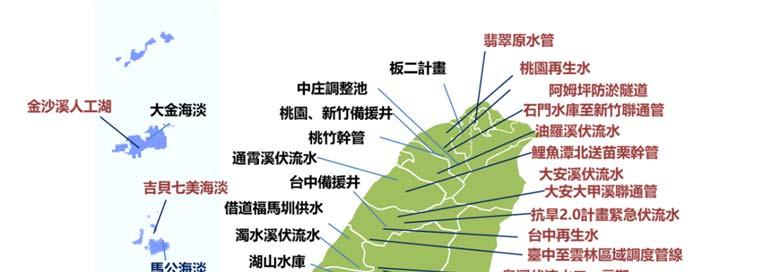
Between - , the promotion of Rainwater Storage and Utilization System has led to the construction of systems, including in schools and in institutions. The estimated annual yields of rainwater collection will exceed , tons per year. For the year between and , more systems will be completed. The annual yield of rainwater collection is expected to exceed , tons per year.
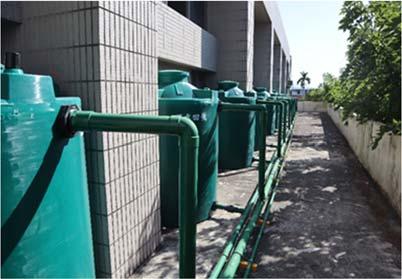
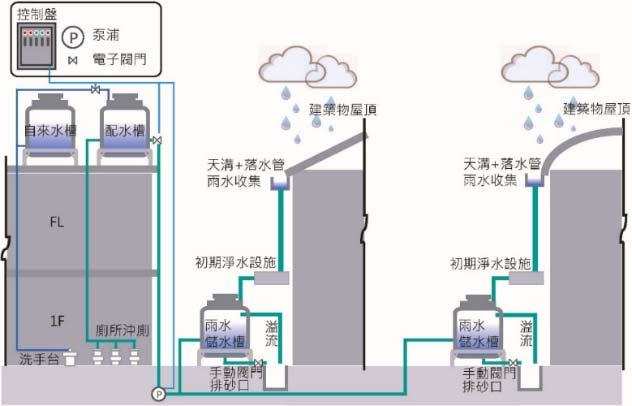
Adaptation Communication 31
Example of Rainwater Storage and Utilization System Process
Example of Miaoli Hegang Junior High School Rainwater Storage and Utilization System
Image source: WRA
Land use- Key Performances
In , subject to the working schedule of the Spatial Planning Act, all municipalities and counties (cities) are required to announce the implementation of spatial plans and proposed adaptation plans for local climate change impact and at-risk areas.
Municipal and county (city) s spatial plans; including risk assessment and climate change adaptation plans
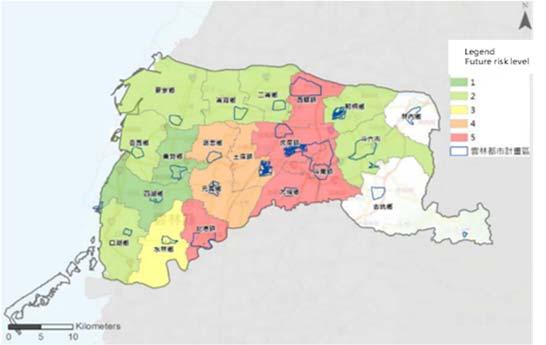
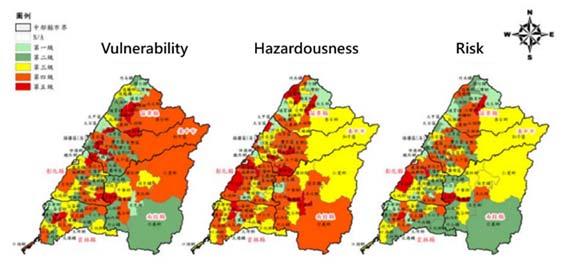
Image source: MOI
To maintain the natural flood retention function of wetlands, the level of importance of wetlands in Taiwan is being reassessed, and Linluo, Dongyuan, Shihlinger Mountain, and Neiliao wetlands have been proclaimed as important local wetlands.
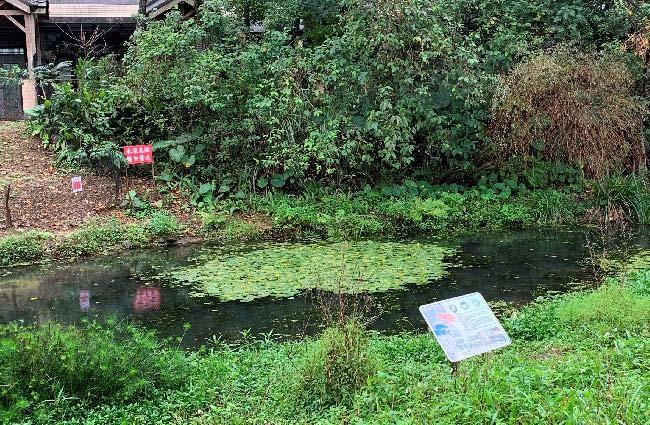
Assessing important wetlands at local-level Dongyuan wetland
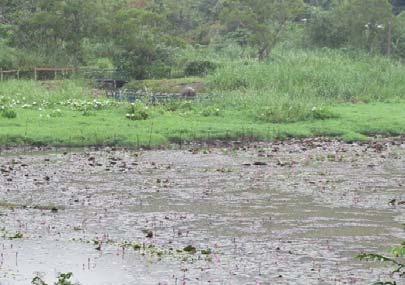
Assessing important wetlands at local-level Neiliao wetland
Image source: MOI
Adaptation Communication 32
Oceans and coasts- Key Performances
Continuous monitoring on sea water quality and environmental data at over locations nationwide. A database has been created to support the study concerning the impact of climate change on the marine environment, and to improve emergency response capacities and early warning capabilities of relevant authorities.
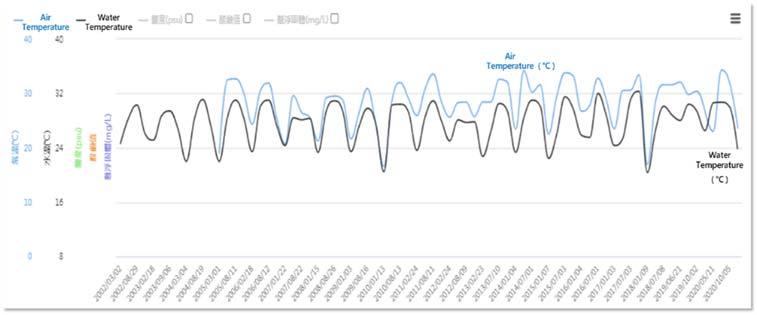
Image source: MOI
Continuously monitoring and investigating on the distribution and population changes of key algal reef ecosystems, cetaceans, seabirds and other marine life species, so as to understand the ecology and biodiversity of our coastal and offshore area.
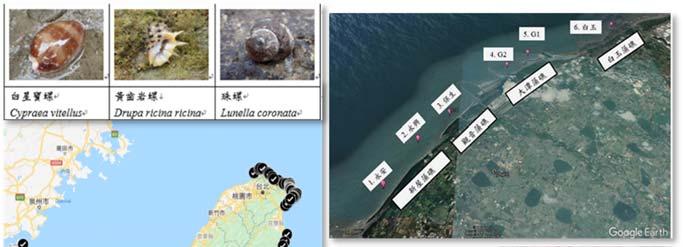
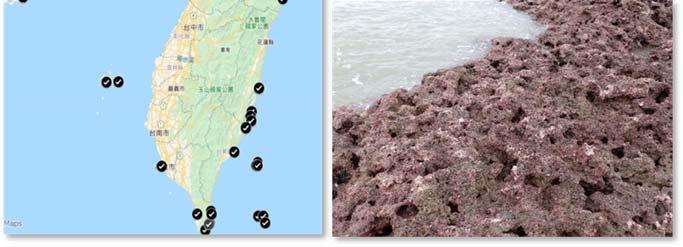
Marine Environment Monitoring Survey of marine biodiversity
Image source: MOI
Review and approval of the first grade coastal conservation plans established t by the Ministry of Economic Affairs. Also, the secondary grade conservation plans established by municipal and/or
Adaptation Communication 33
county s (city) governments shall be approved by the Ministry of Economic Affairs so as to ensure the safety of coastal tribes, the compliance with land use guidelines, and reduce disaster risks, as well.
The location of first and secondary grade coastal protection plans on Taiwan's main island Image source: MOI
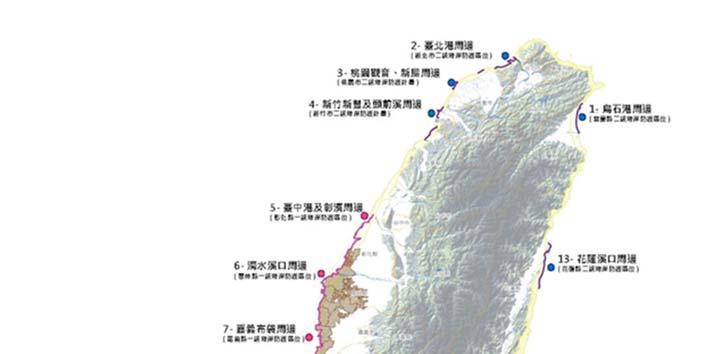
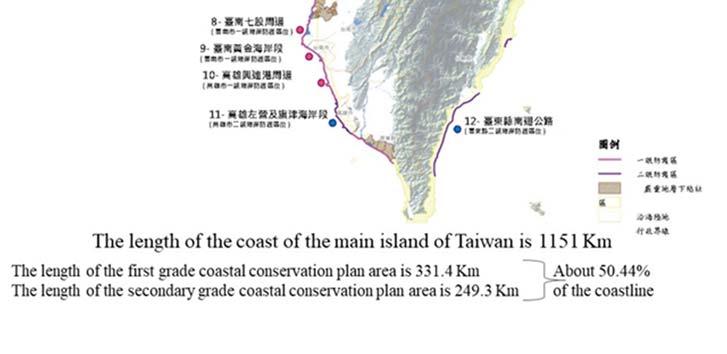
34
Adaptation Communication
Energy supply and industry- Key Performances
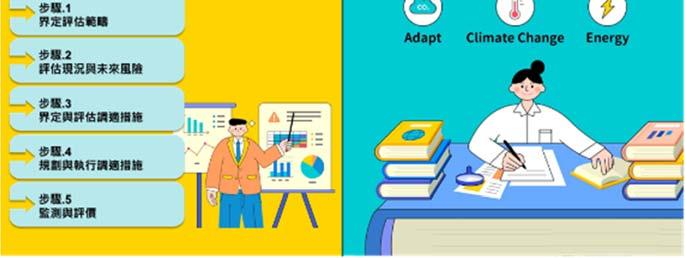
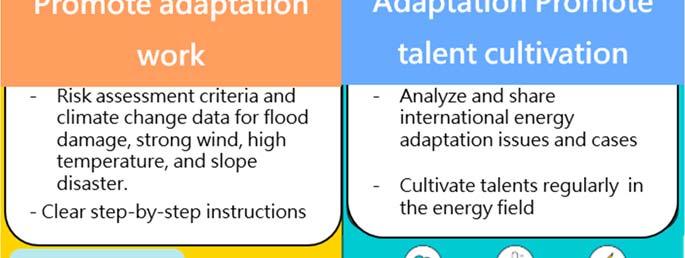
Extreme climate risk assessment criteria applicable to the energy sector for flooding, strong winds, high temperature and slope disasters have been successively developed and provided to the energy sector, along with climate change risk assessment guidelines, maps and platforms to guide energy companies to assess the impact of climate change and relevant risks on energy facilities. In addition, climate change adaptation management procedures have been promulgated for the manufacturing industry to help manufacturers assess transition risks and costs, and enhance their ability to adapt to climate change.
Image source: MOEA
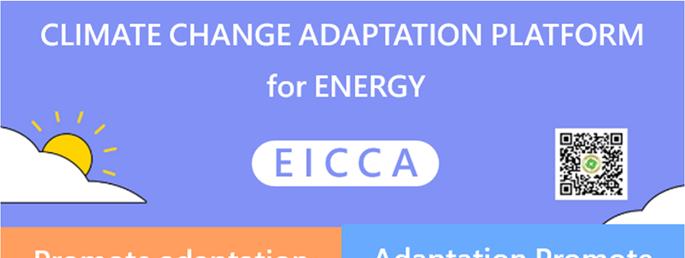
Adaptation Communication 35
Climate Change Adaptation Platform for Energy Sector (EICCA)
Agricultural production and biol ogical diversity- Key Performances
In , the Central Weather Bureau, MOTC assisted in refining the forecast data for major economic crop production zones, and completed the establishment of sets of agricultural weather stations. Currently, more than weather stations can provide information for agricultural applications to develop climate change adaptation strategies. In addition, the system integrates with the disaster database of the crop disaster early warning platform through mobile application and LINE to strengthen farmers' disaster prevention capabilities.
Weather & Agricultural Disaster Prevention mobile application Image source: COA
Users can browse typhoon, high temperature, rainstorm, and strong wind event warnings on the Weather & Agriculture Disaster Prevention mobile application, or search for Agricultural Research and Extension Stations, Agricultural Weather Stations, and view crop areas in specific counties and cities to get detailed weather monitoring information for each location.
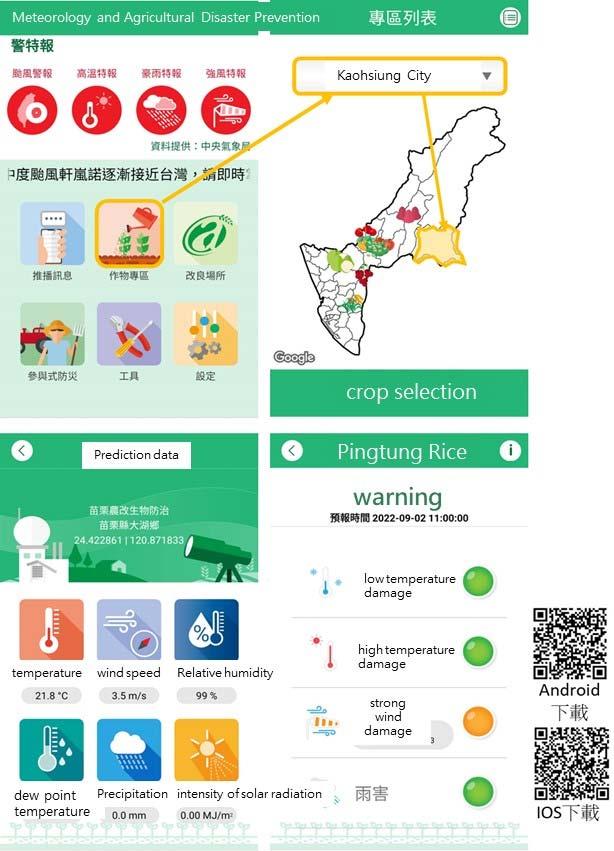
Adaptation Communication 36
Health -Key Performances
Government agencies have collaborated to build a national health weather warning platform and mobile application LOHAS WeatherHealth Service to proactively notify the public of heat (cold) injury, the early warning classification and protective measures. The Health Promotion Administration also uses various channels to carry out heat injury prevention publicity in summer and remind the public to keep warm during cold spells in winter to prevent cardiovascular and respiratory diseases deteriorated by low temperature.
Weather & Agricultural Disaster Prevention mobile application Image source: MOHW
The Occupational Safety and Health Administration of the Ministry of Labor (MOL) has created the High Temperature Outdoor Work Heat Injury Prevention Action Information Website, which allows users to check the heat injury risk level of a designated location online, explore which precautions should to be taken, and access information on nearby medical institutions. In addition, publicity and supervision inspections are carried out as the surveillance measure to strengthen the protection against heat injuries of workers working outdoors at high temperatures.
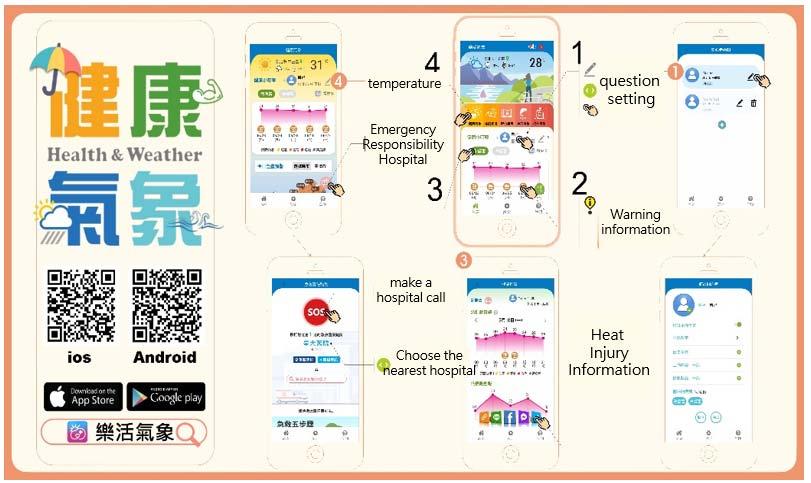
Adaptation Communication 37
High Temperature Outdoor Work Heat Injury Prevention Action Information Web Page Image source: MOHW
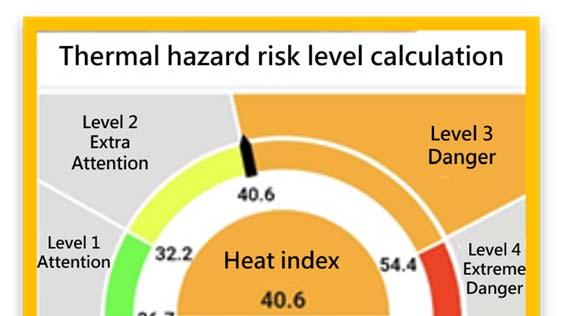
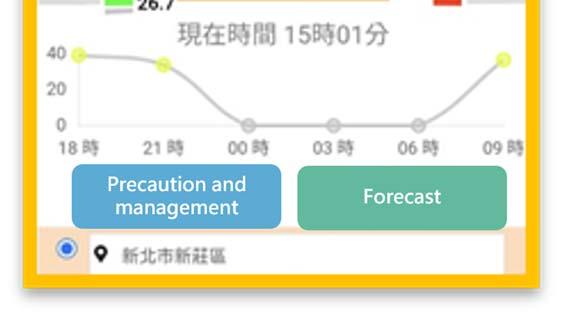
During hot and cold spells, as well as during the Spring Festival, the government works with private resources and nonprofit groups to provide services to homeless people; including food and goods distribution, visits, and continues to strengthen the care for disadvantaged groups.

Communication 38
Adaptation
Image source: MOHW
During the annual Disaster Preparedness and National Defense Mobilization Exercise, disaster emergency response drills are carried out for the national-level disaster medical rescue teams to strengthen emergency medical response capability in the advent of heavy casualties and diseases related to climate change.
National Disaster Medical Ambulance Team (NDMAT) Disaster Emergency Medical Response Drill Image source: MOHW

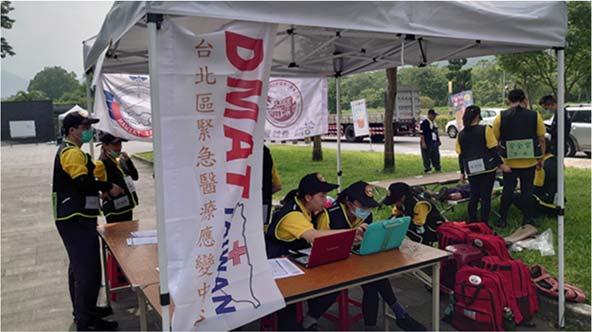

39
Adaptation Communication
Taitung County Government's Annual Disaster Prevention and Rescue Exercise Image source: MOHW
Inspection of the situation of infectious diseases related to climate change and the review of prevention and control actions are done to continue to strengthen the warning and monitoring mechanisms, improve epidemic investigation and various epidemic prevention measures, such as active inspection and removal of breeding sources in the community to reduce the density of mosquitoes vectors of disease.
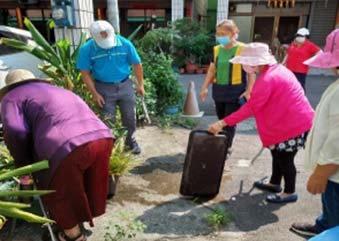
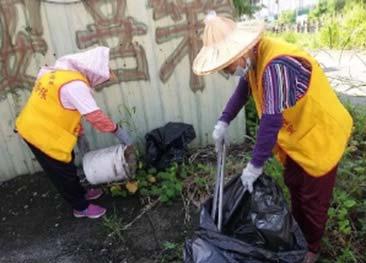
40
Adaptation Communication
People take the initiative to inspect and eliminate the breeding source of vector mosquitoes in the community Image source: MOHW
VI. International cooperation
Climate change is an urgent challenge faced by the international community. As a member of the global village, Taiwan is actively implementing the United Nations Framework Convention on Climate Change (UNFCCC), while also continuing to participate in relevant meetings and work as a Non-Government Organization (NGO) observer.
Taiwan also cooperates closely with diplomatic allies to share with the international community valuable experience in promoting climate change adaptation and environmental protection, as exemplified in the three cases below.
. Belize Urban Resilience and Disaster Prevention Project - Background -
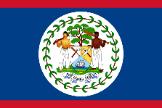
Belize suffers from the threat of extreme rainfall due to climate change. The low-lying coastal plains as well as densely populated zones are the worst-hit areas, resulting in the loss of lives and property. In order to minimize the impact of extreme weather, the Government of Belize and the town council of San Ignacio/Santa Elena have sought assistance regarding the use of a Geographic Information System (GIS) to enhance Belize s capacity in applying technology to reduce disasters. This project is designed to cope with the types of natural disasters that occur in Belize, as well as the existing software and hardware conditions of the country s disaster prevention units, to assist in marking out potential flood areas and strengthening monitoring, as well as establishing an early warning mechanism for floods. Capacity building and training courses will also be included to enhance the technical capabilities of Belize s disaster prevention and protection units.
Adaptation Communication 41
- Case & Results -
This project assists the Belizean government in the use of GIS technology to establish an early warning system and improve flood preparedness and disaster response efficiency, as well as carry out infrastructure improvement at the demonstration site. It is expected that the warning system will be integrated into the country s disaster prevention and rescue system, to substantially reduce the loss of life and property caused by floods in Belize. The main goals of this project include:
. Strengthening overall flood preparedness and prevention, as well as updating basic maps.
. Applying advanced monitoring techniques.
. Carrying out flood control in flood-prone areas.
. Raising awareness and knowledge of disaster prevention.
As of the end of March , the following activities have been completed
. Update of the measurement data of river cross section of National Hydrological Service.
. Update of cadastral maps, land use maps, road maps, river maps, watershed maps, bridge maps, public facilities maps and inundation potential maps.
. Update of the digital terrain model (DTM) with a resolution of . X . meters.
. Completion of the potential inundation simulations of San Ignacio and Santa Elena.
. Completion of the -hour rainfall from mm to mm flooding potential map, based on rainfall data and hydrological data.
. Completion of a set of flood risk maps.
. Completion of four sets of water regimen monitoring stations equipment.
. Completion of an early warning platform system for flood disaster.
Adaptation Communication 42
. Start of the construction project for San Ignacio and Bullet tree village flooding improvement.
. Completion of the preliminary investigation of standards for flood response operations, and related suggestions for improvement.
. Completion of one disaster prevention inter-ministerial response team training in Taiwan.
. Completion of two online disaster prevention education training and one on-site education training in Belize.
. Investigation carried out in Belize for community disaster prevention planning.
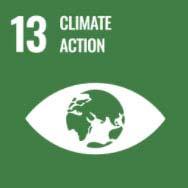
.Completion of flood improvement in San Ignacio urban area, construction of a -meter-long drainage ditch and afoot-long drainage culvert.
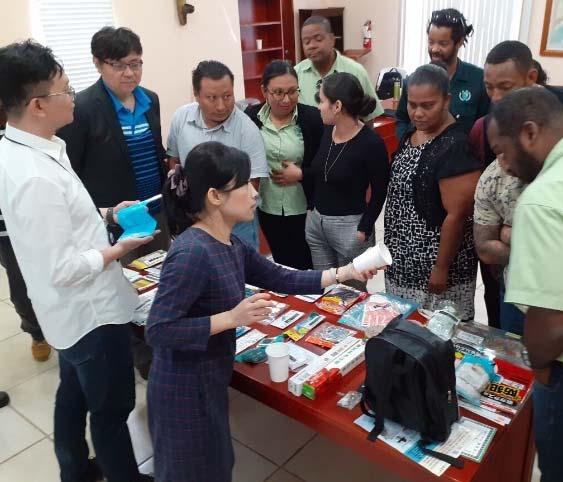
Communication 43
Adaptation
- Sustainable Goals-
Image source: ICDF
. St. Kitts and Nevis Enhancing Agricultural Adaptive Capacity to Climate Variability Project

- Background -
A severe drought occurred in Saint Christopher and Nevis in , causing the total crop output to fall by . percent from the figure, affecting national food security and farmers livelihoods. In response, the country filed a request for assistance from Taiwan. Literature review and fieldwork confirmed that the impact of climate variability and climate change trends are important issues for St. Kitts agricultural development. Initial estimates of St. Kitts agricultural vulnerability revealed that the core problem was the lack of capacity of the country s agricultural sector to respond and adapt to early warning information on climate variability, and that three measures should be adopted to increase the resilience of its agricultural system: establish a data collection mechanism for early warnings; develop and/or introduce crop disaster mitigation and prevention techniques; and increase the availability of agricultural information. When the project is completed, St. Kitts agricultural agencies will establish an information dissemination mechanism for crop disaster mitigation and prevention so that farmers can make use of the available information to minimize damage caused by disasters.
- Case & Results -
As of the end of June , the following activities have been completed:
. Establishment of four agricultural weather stations in the most needed areas with expertise from the Council of Agriculture (COA), Executive Yuan, and the Central Weather Bureau (CWB). These stations have started real-time data collection (http://www.agromet.kn/).
. Visit of three officials of cooperating units in St. Kitts and Nevis to the Central Weather Bureau to undertake technical training in basic weather forecasting and reporting.
. Technical consultation and capacity building by two Taiwanese experts dispatched to St. Kitts and Nevis.
.Establishment of one demonstration farm and four demonstration fields, with crop cultivation trials
Adaptation Communication 44
undertaken and disease and pest monitoring in response to extreme weather conditions. In addition, one annual report on crop disaster mitigation and prevention techniques was published.
. Delivery of on-site capacity building for officials of cooperating units and completion of four SOP manuals (weather station maintenance, on-site data collection, digital image processing and soil fertility evaluation).
. Development of social media group that made announcements on crop disaster mitigation and prevention.
. Organization of events to teach farmers how to make use of agricultural information.
. Organization of seven events to teach farmers how to make use of climate-resistance cultivation skill.


. Establishment of one agricultural information platform (https://goo.gl/gpmExX), and compilation of an annual report on agricultural information dissemination.
. Production of one "Suitable Crop Cultivation Map" and one Annual Climate Risk Calendar in St. Kitts and Nevis."
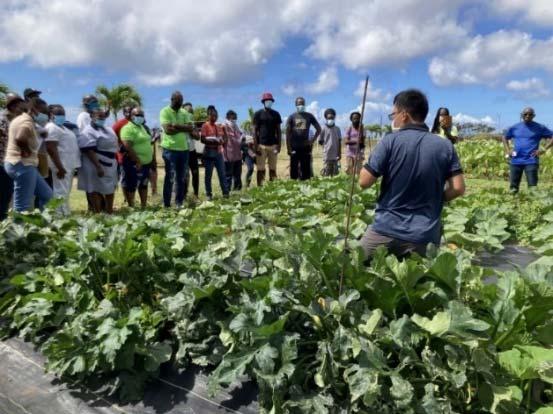
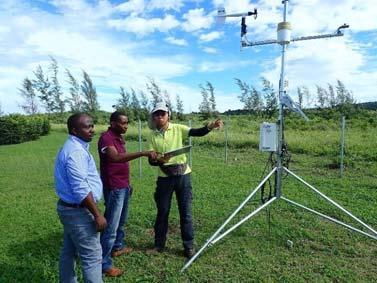
45
Adaptation Communication
Sustainable Goals-
-
Image source: ICDF
. Improving Community Resilience in the Dry Corridor of Honduras Project



- Background -
Disaster resilience has become one of the major topics in the international humanitarian aid community. Honduras is considered one of the most vulnerable countries to climate risks and natural disasters in the world. The southern region of Honduras, which is part of the Dry Corridor in Central America, has suffered from one of the worst droughts in decades. In line with global trends and to assist in addressing the recurrent drought situation, the project aims to enhance resilience to multi-threat scenarios, with a focus on drought in communities located in the Dry Corridor of Honduras.
- Case & Results -
Overall, the project will:
. Increase knowledge and skills of local population to manage risks related to climate variability.
.Improve capacity of local emergency committees for monitoring and forecasting droughts.
.Implement small-scale infrastructures in the target communities.
Adaptation Communication 46
Organization of community disaster training courses
Image source: ICDF
Construction of small community water storage facilities
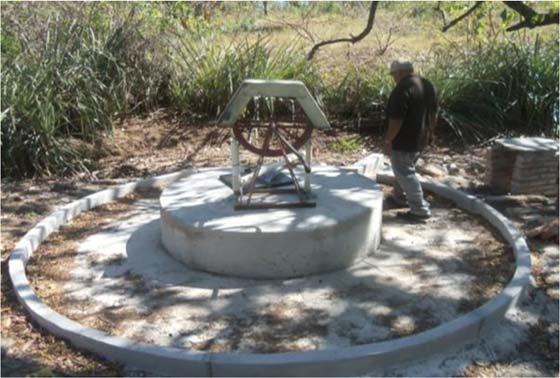
Image source: ICDF
Organization
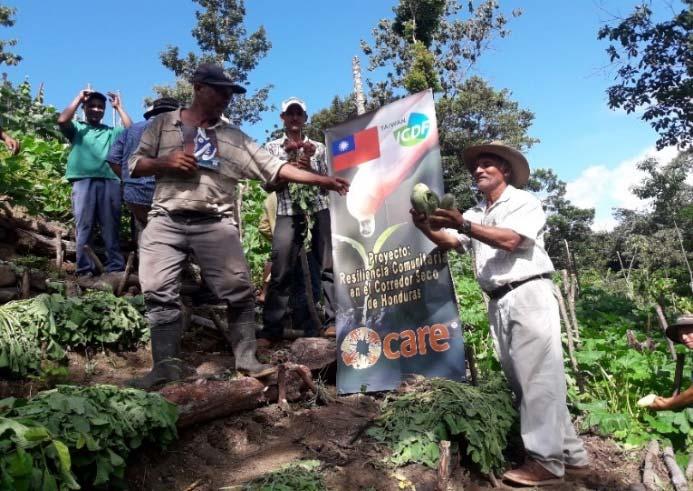
of farmer field training
Image source: ICDF

- Sustainable Goals-

Communication 47
Adaptation




































































